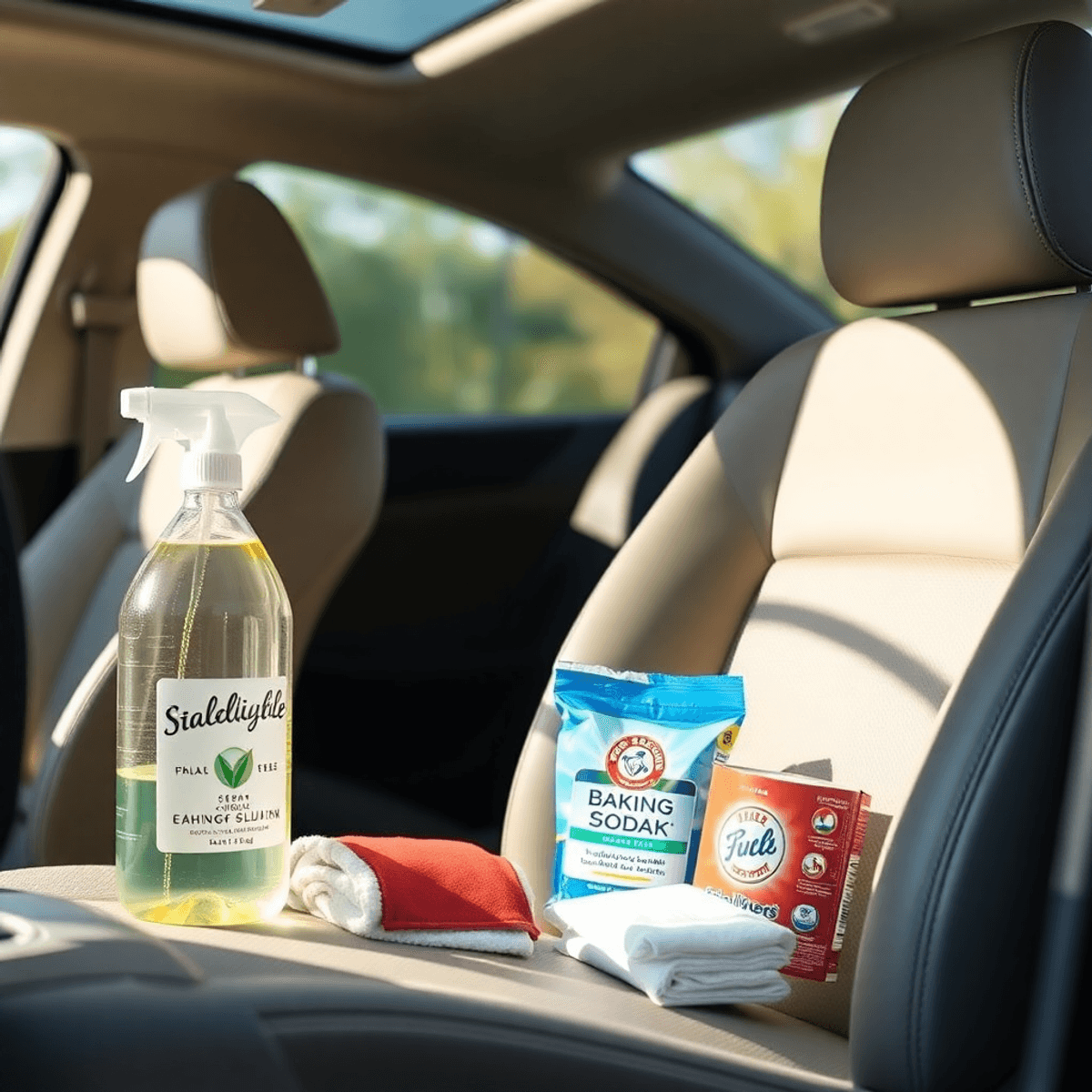
Introduction
Your Car Seats is your personal sanctuary on wheels. A fresh-smelling car creates a pleasant driving experience, boosts your confidence during carpools, and maintains your vehicle’s value. Yet, unwanted odors can turn this sanctuary into an uncomfortable space.
Car seats often become the primary source of persistent smells. These odors can stem from:
- Daily commute sweat
- Food and drink spills
- Pet accidents
- Cigarette smoke
- Mold and mildew
- Children’s messes
These unwanted smells don’t just affect your driving experience – they can leave lasting impressions on passengers and potentially decrease your car’s resale value.
Good news: You can eliminate these stubborn odors with simple, effective solutions. This guide walks you through 5 proven methods to refresh your car seats, using readily available household items and specialized products. You’ll discover how to:
- Use baking soda’s natural odor-absorbing properties
- Create effective vinegar-based cleaning solutions
- Harness the power of dryer sheets
- Mix your own upholstery cleaner
- Maintain freshness with car cologne diffusers
Ready to transform your car’s interior from stale to fresh? Let’s dive into these practical solutions that will help you reclaim your car’s fresh scent and create a more enjoyable driving environment.
Understanding Car Seats Odors
Car seat odors come from various sources that penetrate deep into the upholstery. Here’s what causes those stubborn smells in your vehicle:
Common Odor Sources:
- Food and drink spills that seep into the fabric
- Pet dander and accidents
- Cigarette smoke particles
- Sweat and body oils
- Mold and mildew from moisture
Fabric vs. Leather Care Requirements
Fabric Seats
- Absorb liquids and odors quickly
- Require immediate blotting of spills
- Need regular vacuuming to remove debris
- Benefit from fabric-specific cleaners
- Can hold onto smells longer than leather
Leather Car Seats
- Resist immediate absorption of liquids
- Need specialized leather conditioning
- Require gentle wiping rather than scrubbing
- Must be protected from direct sunlight
- Can develop unique odors from leather aging
Regular Maintenance Impact
A consistent cleaning schedule prevents odor buildup in both seat types. Weekly vacuuming removes surface debris before it settles deeper into the material. Quick response to spills reduces the chance of permanent odors taking hold. The type of cleaning products you use matters – harsh chemicals can damage materials and create additional unwanted smells.
Your car’s ventilation system plays a crucial role in odor prevention. Running the fan regularly helps circulate air and prevent moisture accumulation that leads to musty smells.
Solution 1: Baking Soda for Odor Absorption
Baking soda is a powerful natural deodorizer for your car seats. This common household ingredient works by balancing pH levels and absorbing unwanted odors rather than masking them. Its microscopic crystals trap and neutralize both acidic and basic odor molecules, making it highly effective for various car seat materials.
Sprinkling Method:
- Vacuum your car seats thoroughly
- Sprinkle a generous layer of baking soda across the Car Seats
- Use a soft brush to work the powder into the fabric Car Seats
- Let it sit for 6-8 hours or overnight
- Vacuum thoroughly to remove all residue
Paste Application for Tough Odors:
- Mix 2 parts baking soda with 1 part water
- Create a thick, spreadable paste
- Apply directly to problem areas using a soft cloth
- Allow to dry completely (2-3 hours)
- Brush off dried residue and vacuum
Tips for Maximum Effectiveness:
- Apply on a dry, sunny day to ensure proper drying
- Use fresh baking soda for best results
- Target both seat surface and crevices
- Repeat treatment weekly for persistent odors
- Store an open box of baking soda under seats for continuous odor absorption
For leather seats, test the paste on a small, hidden area first to ensure it won’t damage the material. The baking soda treatment can be safely repeated as needed without risking damage to your Car Seats
Solution 2: White Vinegar Solution
White vinegar is a powerful natural odor neutralizer for your car seats. This common household item contains acetic acid that breaks down odor-causing compounds while disinfecting surfaces.
Creating Your Vinegar Solution:
- Mix 1 part white vinegar with 2 parts water in a spray bottle
- Add 2-3 drops of essential oil (optional) to mask vinegar smell
- Shake well before each use
Application Process:
- Test the solution on a small, hidden area first
- Spray the mixture lightly on affected areas
- Let it sit for 3-4 hours (preferably on a sunny day)
- Wipe with a clean microfiber cloth
- Leave windows open to air dry completely
White vinegar is effective at eliminating tough odors like:
- Cigarette smoke
- Pet accidents
- Mildew from moisture
- Food spills
- Body odors
Pro Tips:
- Apply on a warm, dry day for faster evaporation
- Don’t oversaturate the seats to prevent moisture buildup
- Use a fan to speed up the drying process
- Repeat treatment for stubborn smells
This eco-friendly solution costs significantly less than commercial cleaners and leaves no harmful residues. The vinegar smell dissipates completely once dry, taking the unwanted odors with it.
Solution 3: Using Dryer Sheets
Dryer sheets are an effective solution for eliminating tough car odors, especially cigarette smoke. These lightweight fabric sheets contain specialized compounds that neutralize and absorb unwanted smells while releasing a pleasant fragrance.
Here’s how to use dryer sheets effectively in your car:
1. Initial Preparation
- Remove all items from your car
- Open all doors and windows for ventilation
- Vacuum seats thoroughly, paying attention to crevices
2. Application Process
- Rub fresh dryer sheets directly on seat surfaces
- Use gentle, circular motions to transfer the fragrance
- Pay extra attention to heavily affected areas
- Replace sheets when they lose their scent
If your car seats have stubborn stains, consider using some of these cleaning tips before applying the dryer sheets for optimal results.
3. Strategic Placement
- Place fresh sheets under each seat
- Tuck sheets between seat cushions
- Add sheets to storage compartments
- Replace every 1-2 weeks for continuous freshness
Pro Tips for Maximum Effect
- Use unscented dryer sheets for sensitive passengers
- Double up sheets in high-odor areas
- Keep spare sheets in your glove compartment
- Combine with regular vacuuming for best results
The fabric softening agents in dryer sheets create a protective barrier that helps prevent new odors from settling into your car seats. This method works exceptionally well for both fabric and leather surfaces, providing a cost-effective solution for maintaining fresh-smelling car interiors.
Solution 4: DIY Upholstery Cleaner Recipe
Creating your ownCar Seats cleaning not only saves money but also gives you control over the ingredients used on your car seats. Here’s a powerful DIY solution that tackles both stains and odors:
Basic Recipe Ingredients:
- 1/4 cup baking soda
- 1 cup warm water
- 2 tablespoons dish soap
- 1 tablespoon white vinegar
- Clean spray bottle
Enhanced Recipe for Tough Stains:
- Add 2 tablespoons hydrogen peroxide, which is known to be effective for cleaning stains off upholstery, as detailed here
- 1 teaspoon enzyme cleaner
Application Process:
- Mix ingredients thoroughly in the spray bottle
- Test on a small, hidden area first
- Spray the solution lightly on affected areas
- Let sit for 15-20 minutes
- Blot with a clean microfiber cloth
- Use circular motions to work the cleaner into stubborn stains
- Wipe with a damp cloth to remove residue
- Allow seats to dry completely
Tough Stain Tips:
- For grease stains: Apply cornstarch before the cleaning solution
- For protein-based stains: Use cold water instead of warm
- For ink marks: Dab with rubbing alcohol before applying the cleaner
This DIY solution works effectively on both fabric and leather Car Seats, though you’ll want to use less liquid on leather surfaces. The combination of ingredients creates a powerful cleaning action that breaks down stains while neutralizing unpleasant odors trapped in the upholstery fibers.
When using vinegar in your cleaning solutions, it’s important to note some best practices, which you can find more information about here. Additionally, if you ever find yourself in a situation where your cleaning efforts seem to make things worse, remember that there are specific strategies you can employ to rectify those situations, as discussed in this thread.
TIP: For More Info On Car Seats Cleaning Click here
Solution 5: Long-term Management with Car Cologne Diffusers
Car cologne diffusers offer a sustainable solution for maintaining a fresh-smelling vehicle interior. You’ll find several types available in the market:
- Vent Clip Diffusers: These attach directly to your car’s air vents, dispersing fragrance when the air conditioning runs
- Under-Seat Diffusers: Compact containers that slowly release scent throughout your vehicle
- Hanging Diffusers: Traditional options that hang from your rearview mirror
- Electronic Diffusers: Plugin devices that allow you to control scent intensity
Selecting the right diffuser depends on your specific needs:
- Scent Intensity: Vent clips provide strong immediate fragrance, while under-seat options offer subtle, consistent scenting
- Duration: Electronic diffusers last longest, typically 2-3 months, compared to hanging diffusers’ 2-4 weeks
- Placement Preference: Consider your car’s layout and where you’d prefer the diffuser to be located
The benefits of using car cologne diffusers include:
- Continuous odor masking without repeated applications
- Customizable fragrance intensity
- Protection against new odors forming
- Cost-effective long-term solution
- No residue or mess compared to sprays
For optimal results, rotate between two different scents every few weeks to prevent nose blindness, and place diffusers strategically near air flow points in your vehicle.
Preventative Measures for Future Odor Control
Regular maintenance creates a fresh-smelling car environment. Here’s your action plan to prevent unwanted odors on Car Seats:
Daily Habits
- Remove trash, food wrappers, and beverage containers
- Keep windows cracked open for 15 minutes when parked
- Wipe down seats with a microfiber cloth
Weekly Tasks
- Vacuum seats thoroughly, including crevices
- Check under seats for forgotten items
- Empty and clean cup holders
Protective Equipment
- Install waterproof seat covers
- Use all-weather floor mats
- Keep spill-absorbent cloths in your car
- Place activated charcoal bags under seats
Air Quality Management
- Install a small USB-powered air purifier
- Replace cabin air filters every 15,000-30,000 miles
- Use moisture absorbers during humid seasons
Immediate Action Protocol
- Clean spills within 15 minutes
- Blot stains – never rub
- Apply baking soda to fresh spills
- Keep an emergency cleaning kit in your trunk
These preventative measures reduce the need for deep cleaning. A clean car maintains its value and creates a healthier driving environment. Set calendar reminders for your cleaning schedule to stay consistent with maintenance.
FAQs (Frequently Asked Questions)
What are common sources of odors in car seats?
Common causes of odors in car seats include food spills, pet accidents, and smoke. Understanding these sources can help in effectively addressing the odors.
How does baking soda help eliminate odors from car seats?
Baking soda works as an odor absorber by neutralizing unpleasant smells. You can use it by sprinkling it on the affected area or creating a paste for deeper cleaning. For maximum effectiveness, allow it to sit for several hours before vacuuming it up.
Can I use white vinegar to clean my car seats?
Yes, white vinegar is an eco-friendly cleaner that can neutralize odors effectively. To use it, mix equal parts of water and vinegar in a spray bottle, apply to the affected areas, and wipe with a cloth. It is particularly effective against smoke and mildew odors.
What is a DIY upholstery cleaner recipe I can make for my car seats?
A simple DIY upholstery cleaner can be made using ingredients like dish soap, white vinegar, and water. Mix them in a spray bottle and apply to stains or odor-prone areas. Follow up with blotting the area with a clean cloth until dry.
How do car cologne diffusers help with long-term odor management?
Car cologne diffusers release pleasant scents that mask unwanted odors and keep your Car Seats smelling fresh over time. When choosing one, consider your personal scent preferences and place it strategically in your vehicle for optimal results.
What preventative measures can I take to avoid future odors in my car seats?
Regular maintenance is key to preventing odors. Establish a cleaning schedule, use Car Seats covers or mats to protect against spills, and ensure good air circulation within the vehicle. These practices will help maintain a fresh-smelling environment.




